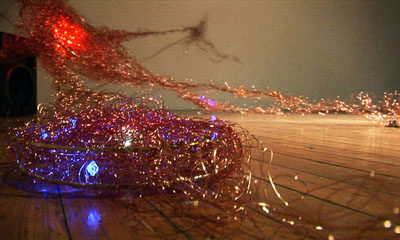Smart art: when art imitates life
April 8th, 2009
Categories: MFA Thesis, Multimedia, Museums, Software, Sound Art, VR Art

About
To see the original on-line article see MEDILL Reports Chicago
by Kathryn Murphy
Leonardo da Vinci, Samuel Morse, Alexander Graham Bell, Buckminster Fuller. There is no shortage of artists involved with science and scientists involved with art.
So it comes as no surprise that a series of lectures on the connection between art and science has been included in Science Chicago, the year-long program of science events throughout the city of Chicago and the surrounding suburbs.
AnnMarie Cernoch, adjunct professor at the Illinois Institute of Art in Chicago and 3-D artist kicked off the series Tuesday at the Illinois State Museum Chicago Gallery located in the Thompson Center. Cernoch focused the discussion on the kinetic sculptures that were part of her MFA work in the Electronic Visualization Laboratory at the University of Illinois at Chicago.
“I think art and science have always had a relationship,” Cernoch said. “Even back to the impressionist painters, all oil paints use minerals to create paintable pigments. Artists have used their imaginations to create images of impossible feats, like M.C. Escher and walking on the ceiling, but the scientists make them possible, like anti-gravity chambers at NASA.”
While her materials were basic - a laptop, simple soundboard, table microphones, thousands of yards of jewelry wire to name a few - Cernoch said her work is about “merging biological objects with technological advancements, a more geological cyborg of sorts.”
Cernoch’s “Replication of System” sculpture mimics the flow of information of a brain cell, specifically a neuron. Neurons carry messages through the body via electrochemical reactions. Basically, an impulse is received by a part of the neuron called a dendrite. The message then travels to the cell body, or soma, and back out of the neuron through the axon, where it transmits that message to another neuron through a junction called a synapse.
As Cernoch said, imagine the messages being sent “along tree branches reaching out to other tree branches.”
For Cernoch’s sculpture, audience voices and feet-stomping act as the impulses or input into the cell. Two types of microphones located on the appendages of the sculpture pick up sound and vibration, which travel along the yards of jewelry wire to the immense mound of mangled up wire serving as the cell body. The impulses get processed by a laptop, and the cell reacts in the form of LED lights.
This biological metaphor is made possible with the technology of human-computer interaction, the programming for which Cernoch received help from Ratko Jagodic, a PhD student at the lab.
“This is huge right now,” Cernoch said. “Think iPhone and touch sensors, instead of just typing and mouse input. The laptop acts as the brain here, taking all the info in.”
Cernoch also discussed two of her sculptures that imitate life. Her blue, glowing “Bendybots” mimic ocean plant life swaying to a current as electronic pulses stimulate wire pulleys to drag the robots back and forth.
“Infinity Gliders,” Cernoch’s third sculpture, simulate an “optical illusion of infinite space,” with a set of mirrors and “gravity-defying” robots powered with small motors and magnets.
With her sculptures, Cernoch simply explores the scientific concepts she finds most interesting.
“I’ve always been fascinated by the concept of black holes,” she said. “This void we can’t find the end of, grasping towards something that isn’t there. We can’t touch it, but we want to.”
Paul Catanese, a faculty member in interdisciplinary arts at Columbia College, said observing certain phenomenon and finding ways to translate that into creative output is part of this “great movement to conflate art and science.”
“When done right,” he said, “combining art and science results in both good art and good science. It’s great to see a budding MFA follow that curious line.”
Jane Stevens, associate curator for the gallery, was surprised at how much science Cernoch accomplished with the materials she used.
“I love the fact that she works with such simple materials,” Stevens said. “I thought you needed so much money and funding to do all of that stuff, but if you use a little creativity, it’s not necessary.”
For Nancy Vachon, a book and paper-making artist from Garfield Park, the science was a little beyond her, but she enjoyed the lecture nonetheless.
“Visually it’s very stunning, but technically I’m swimming,” Vachon said. “I’m not a digital person. I can see where she’s going, but if given the parts, there’s no way I could put them together.”
It is important not to get overawed by technology, according to Joan Truckenbrod, professor of art and technology at the School of the Art Institute of Chicago.
“Technology has a powerful aura, a way of projecting itself as being all important and all powerful,” Truckenbrod said. “But it’s also a vehicle that allows us to do artistic work that we couldn’t do with traditional materials.”